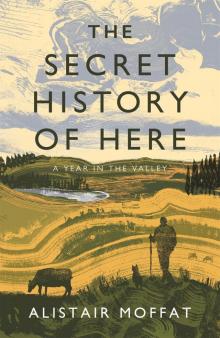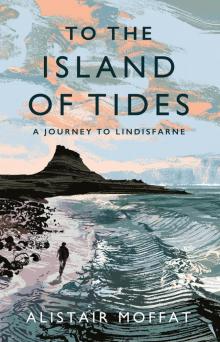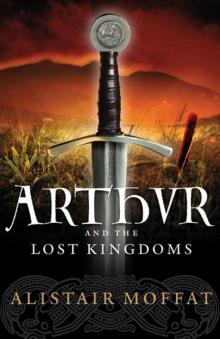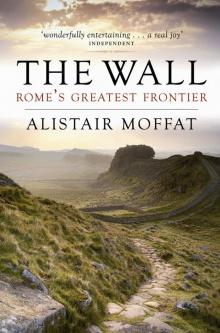- Home
- Alistair Moffat
The Wall
The Wall Read online
The Wall
This eBook edition published in 2012 by
Birlinn Limited
West Newington House
Newington Road
Edinburgh
EH9 1QS
www.birlinn.co.uk
Copyright © Alistair Moffat 2008
The moral right of Alistair Moffat to be identified as the author of this work has been asserted by him in accordance with the Copyright, Designs and Patents Act 1988
All rights reserved. No part of this publication may be reproduced, stored or transmitted in any form without the express written permission of the publisher.
ISBN: 978-1-84158-789-9
eBook ISBN: 978-0-85790-481-2
British Library Cataloguing-in-Publication Data
A catalogue record for this book is available from the British Library
In memory of Malcolm Thomas
Contents
Acknowledgements
List of Illustrations
Map
Preface
Introduction: Remembering the Empire
1 Caesar, Claudius and the Elephants
2 Britannia Barbarica
3 The North Road
4 Dinner on the Stone Road
5 The Day the Empire Came
6 Let One Stone Stand Upon Another
7 Abandonment, Invasion and Desertion
8 After Britannia
9 Days on the Wall
Appendix 1: Significant Roman Emperors During the Time of Britannia
Appendix 2: Significant Governors of Britannia
Bibliography
Index
Acknowledgements
Sandy Mackie – sorry, that’s Mr Mackie – taught me history at Kelso High School, and he certainly made an impression. This is the fourteenth history book I have written. Perhaps at last he should be seen to shoulder some of the responsibility. I gladly accept all of the blame.
Hugh Andrew and his superb team at Birlinn are blameless, of course. Excellent publishers, with great enthusiasms, thorough professionalism and always up for a laugh; they have had a great deal to put up with. Thanks to all.
My agent, David Godwin, also puts up with me and as ever I am grateful for his sage advice. Thanks to him.
Liz Hanson has once again adorned a book with her perceptive photographs. I am glad to have supplied an extended caption. Many thanks.
Paddy Merrall and Graeme Thompson of ITV Border and ITV Tyne Tees respectively and jointly commissioned a TV series based on this book. I am grateful for their faith and confidence. Valerie Lyon directed the series with aplomb – and tact. It gave me the chance to make a journey along the Wall with my co-presenter, Tanni Grey Thompson, and with Paul Dobson, Allan Tarn, Paul Caddick, and Beth Moffat. It was great fun, and very informative. Thanks to all.
Robin, Patricia, Andrew and Tony Birley are simply an adornment to the Wall and its history. Robin, Pat and Andrew’s stewardship of Vindolanda is inspirational and Tony Birley’s scholarship exceptional. I am very grateful to all of them for their patience and kindness.
And to everyone who listened to my incessant moaning as I wrote this book, I apologise. I enjoyed the journey very much. This never became that damned book at any time in its writing. Hadrian’s Wall is a fascinating subject, and I remain fascinated.
Alistair Moffat
Selkirk, December 2007
List of Illustrations
1. Chesters Fort
2. The remains of the vicus at Vindolanda
3. How the Wall might have looked – the reconstruction at Vindolanda
4. Barcombe Hill behind Vindolanda
5. Housesteads Fort
6. The south-west corner of Housesteads Fort
7. Buildings beyond Housesteads Fort
8. The only section of the Wall where walking is permitted, west of Housesteads Fort
9. Sycamore Gap
10. Part of the central section looking towards Crag Lough and Hotbank Farm
11. Stones for the arch at milecastle 37
12. The Whin Sill and the central section
13. Wall foundations with a dyke built from Roman stone in the central section
14. A detail of the Wall
15. The steep gradient of the Whin Sill
16. Detail of the Wall near Housesteads
17. The quarry at Walltown, which took a bite out of the Wall
18. The rubble core of the Wall at Walltown
19. The early turret at Walltown Crags
20. Milecastle, near Birdoswald
21. An impressive run of wall east of Birdoswald
22. Birdoswald Fort
23. Turret at Birdoswald
24. Poltross Burn milecastle, near Birdoswald
25. The garrison city of Dura Europos
26. Gonio, on the Black Sea coast in Georgia
27. Massive frontier defences along the Euphrates frontier at Halabiya, Syria
28. The superbly built stone praetorium at Halabiya
29. The frontier forts at Hallabat, Jordan
30. The Hunting Baths at Leptis Magna in Libya
31. The immense cistern at Rasafa
32. A magnificent stretch of Roman road behind Tarsus, Turkey
Preface
There is something about barricades, high ramparts overlooking long vistas, crenellated walkways patrolled by watchful soldiers, strong towers, formidable castles. Perhaps the attraction comes from years of television and film: American Indians charging across the plains, whooping and yelling, hurtling towards camera, loosing off arrows at the good guys safe behind the stockade; or baddies assaulting the walls of mighty castles while desperate defenders hurl everything and anything that comes to hand. Feeling safe inside from danger outside – probably a primitive instinct lurking in the shadows of many a subconscious.
Ramparts are attractive – and surely none more than Hadrian’s Wall. There is nothing else remotely like it west of China, nothing bigger, grander, more masterful and more impressive. Standing on the Whin Sill at Housesteads Fort, looking over the northern moorland, perhaps scanning the horizon for a flicker of movement, or up at Walltown Crags, where the Wall glowers over grey Thirlwall Common, there is a sense of borrowed authority, of let them come or, to paraphrase a little, let them gaze upon my works and despair.
Even though it nowhere rises to its original height, and long stretches of it have disappeared, power pulses from Hadrian’s Wall. Built by a culture galvanised by the will of one man, it is a miracle of self-aggrandisement and ancient disregard for practicalities. A mighty Wall which divides our island, devised by conquerors to limit their empire, it somehow still manages to play to the little boy and his toy soldiers in an imagined landscape.
Although it never marked a cultural frontier, or the line along which the border between England and Scotland would eventually run, Hadrian’s Wall nevertheless had an important early role in creating an idea of the north of Britain. For almost three centuries, savagery and danger lay beyond it. The north was threatening while the south was sunlit, civilised, sophisticated. It is impossible to say when or how these notions came into play, but they are there, as surely as the Wall. And its story is fascinating.
This book attempts to tell the story, beginning as early as seemed sensible. Along the way the text contains many boxed items of information which seemed interesting, even important, in themselves but did not necessarily fit into the narrative. They can be read as asides, skipped and read later, or ignored. The last chapter is also not part of the narrative. Having spent a lot of time on Hadrian’s Wall over the past two years and knowing it reasonably well, it occurred to me that an itinerary taking in the places I enjoyed most might be more helpful than an exhaustive list of internet addresses and opening times.
Others will have different views, but I found the visits to the places set out in the last chapter very pleasurable.
As I was finishing this book, in December 2007, my father-in-law, Malcolm Thomas, died. He had been a regular soldier, a man with many old-fashioned virtues and few old-fashioned opinions. Cawfields milecastle would have made him smile with recognition of its daftness, and the whole enterprise of building and garrisoning the Wall would have prompted perceptive and informed comments. I am sorry not to have them, and out of the greatest respect and affection, this book is dedicated to his memory.
Introduction: Remembering the Empire
Hadrian’s Wall is the largest, most spectacular and one of the most enigmatic historical monuments in Britain. Nothing else approaches its vast scale: a land-wall 73 miles from east to west and a sea-wall stretching at least 26 and probably 50 miles down the Cumbrian coast. Many of its forts are as large as Britain’s most formidable medieval castles, and the wide ditch dug to the south of the land-wall, the Vallum, is more monumental than any prehistoric earthwork.
And yet the story of the great Roman Wall, its builders and originators, was almost immediately misunderstood, confused or forgotten. Only five or six generations after the end of Roman Britain in the early fifth century the name of Hadrian had faded completely and been disconnected from his mighty creation, the dates of its construction had been got wildly wrong and the historical sequence of events had fallen badly out of kilter. The Wall still dominated the landscape, many thousands had lived along its length for three hundred years, a dozen great forts were still standing, inscriptions offering names and dates were everywhere – how did early historians fail to record even the rudiments of its story?
Gildas was probably a son of the Old Welsh-speaking kingdom of Strathclyde, born some time around AD 504 at Dumbarton on the Clyde. Having become a monk, he composed a fiery sermon On the Ruin and Conquest of Britain. Calling them ignorant tyrants, he raged against the corrupt and feckless contemporary British kings who were allowing the Picts and the Scots to raid from the north and pagan Germanic warriors from across the North Sea to settle large swathes of eastern and southern England. It is a splendid froth of invective probably composed in the 560s, and is one of the earliest written British sources to survive in the post-Roman period. Interspersed amongst the insults are snippets of history, or at least tales which Gildas clearly believed were true. And some of them refer to Roman walls.
Magnus Maximus was an ambitious general in the late western Empire and in 383 he attempted to usurp the imperial throne. Having raised an army in Britain, he crossed the Channel to campaign in Europe, ultimately meeting defeat and execution at Aquileia in northern Italy. Gildas blamed Maximus for the troubles which then befell the old province of Britannia:
After this, Britain is left deprived of all her soldiery and armed bands, of her cruel governors, and of the flower of her youth, who went with Maximus, but never again returned; and utterly ignorant as she was of the art of war, groaned in amazement for many years under the cruelty of two foreign nations – the Scots from the northwest, and the Picts from the north.
After tearful and piteous entreaties from an embassy of Britons, Rome sent a legion which promptly came into close conflict with the cruel enemies and slew great numbers of them. On the advice of their Roman rescuers, the British:
now built a wall across the island from one sea to the other, which being manned with a proper force, might be a terror to the foes whom it was intended to repel, and a protection to their friends whom it covered. But this wall, being made of turf instead of stone, was of no use to that foolish people, who had no head to guide them.
Gildas was describing the Antonine Wall, built in turf between the Firths of Forth and Clyde on the orders of the Roman Emperor, Antoninus Pius, in the AD 140s. If he had been born in Dumbarton, very near the western terminal, Gildas would have known the old turf wall very well. His dating is badly wrong, reckoning its construction 250 years later, in the 390s. And Gildas also thought it the first great wall to be built in Britain, whereas it in fact postdates Hadrian’s Wall. Perhaps the rapid abandonment of the Antonine Wall after 161 gave rise to the belief that it was of no use.
Another pathetic embassy to Rome, according to Gildas, produced a second expedition to Britain, and it was effective, planting terrible swords upon the shoulders of their enemies, they mow them down like leaves which fall at the destined period. This time the Romans set about building a second, much better, wall themselves.
With the help of the miserable natives, [they] built a wall different from the former, by public and private contributions, and of the same structure as walls generally, extending in a straight line from sea to sea, between some cities, which, from fear of their enemies, had there by chance been built.
This seems like a description of Hadrian’s Wall, with Roman Carlisle at the western end and perhaps Corbridge near the eastern. But it turned out to be no more effective than the turf wall, sighed Gildas. Once the Romans had departed, the assaults from the Picts and Scots resumed:
To oppose them was placed on the heights a garrison equally slow to fight and ill adapted to run away, a useless and panic-struck company, who clambered away days and nights on their unprofitable watch. Meanwhile the hooked weapons of their enemies were not idle, and our countrymen were dragged from the wall and dashed against the ground.
Even allowing for the fact that he was writing an invective, Gildas’ account is surprisingly poor. Only the persistent attacks of the Picts and the Scots appear to be historically accurate. Astonishingly, he believed that the construction of Hadrian’s Wall was recent, not long before his own lifetime, 400 years later than its actual foundation in AD 122.
Gildas saw himself as a beacon of learning in the dimming days of the Dark Ages, in a post-Roman Britain which was sliding into anarchy: as a paragon of literacy, Latinity and a devout Christian aware of European as well as British history. How did he get it all so wrong?
A truly great historian, Bede of Jarrow, was similarly confused about who built what and when and why. He lived in the shadow of Hadrian’s Wall; his monastery and his church of St Paul’s were built with Roman stone robbed out of nearby forts and from the Wall itself, and, like the early church, the Northumbrian kings who were his patrons and protectors saw themselves in part as the heirs of Britannia, the Roman province which lasted almost 400 years. But in his Ecclesiastical History of the English People, completed in 731, Bede still gets it wrong, although not as badly as Gildas. A superb researcher, a genuine scholar who checked his facts, looked for more than one source, he adapted the BC/AD system of dating and made it a standard so that he could get the sequences of events in the right order and make all clearer. He understood that the stone wall north of the Tyne was built first, but he believed that it was done on the initiative of the Emperor Septimius Severus, and nowhere mentions Hadrian. That places its construction in the early third century not the early second. Also Bede insisted that it was an earthwork first, a wall of turf topped by a timber palisade. Then he adopts Gildas’ version of events and adds some helpful personal observation:
This famous and still conspicuous wall was built from public and private resources, with the Britons lending assistance. It is eight feet in breadth, and twelve in height; and, as can clearly be seen to this day, ran straight from east to west.
Bede had obviously seen the Wall for himself. In fact some scholars believe that he was born at a place called Ad Murum, literally ‘At the Wall’, a settlement on the site of what became the city of Newcastle. Bede was naturally curious, and it is surprising that he did not undertake research into a phenomenon which lay so close at hand – and that he was content to accept Gildas’ garbled account.
After the eighth century the Wall seemed to pass out of knowledge, its mighty ruins mouldered in the landscape, overgrown and ignored. Medieval churches near the line used it as a quarry of dressed stone, and farmers made dykes for their inbye fields out of the tu
mbledown turrets and forts.
It would be many centuries before the story of Hadrian’s Wall became clearer, before its context was understood and before archaeology could begin to reveal an astonishing wealth of information. The sixteenth-century antiquary William Camden was greatly impressed with the scale and sweep of the Roman Wall but unable to see as much of the magnificent central section as he would have liked. Border Reivers – rank robbers he called them – had occupied at least one of the major forts and made the countryside unsafe for travellers. The study of Hadrian’s Wall developed real momentum in the eighteenth century when all things Roman and Greek were becoming generally fashionable. William Stukely and other scholars took a detailed interest and by the nineteenth century a formidable group of northern antiquaries at last began to uncover the real narrative behind this amazing monument.
Very little in what follows is original and much depends on the superb corpus of research and archaeology produced in the last sixty years. But there are differences of emphasis. The native British story of Hadrian’s Wall cannot be easily told: neither the archaeology nor written sources exist in any quantity. Such records as do are gossamer scant, mostly allusory or opaque. But an attempt must be made. How the native peoples treated the Wall and its builders and garrison is a vitally important component too often relegated to the background, only faintly heard as mood music behind the onward march of the legions. After all, the native kings and their warriors had a motive role in persuading Hadrian to build a wall, and not just any barrier but a truly monumental solution to a serious military problem. The following pages attempt to find more of a role for the British, the ancestors of many of most of us.
Another difference in emphasis is prompted by the remarkable letters and lists found at the fort at Vindolanda which lies a kilometre or so to the south of the central sector of the Wall. These unique records predate the arrival of Hadrian and his builders in AD 122 by twenty years but they shine a brilliant light on the everyday lives of the Roman garrison in the north – and even occasionally have something to say about the natives. The Vindolanda letters and lists insist on a central place in any understanding of Hadrian’s Wall.

 The Secret History of Here
The Secret History of Here The Night Before Morning
The Night Before Morning To the Island of Tides
To the Island of Tides Arthur and the Lost Kingdoms
Arthur and the Lost Kingdoms Britain’s Last Frontier
Britain’s Last Frontier The Faded Map: The Lost Kingdoms of Scotland
The Faded Map: The Lost Kingdoms of Scotland The Wall
The Wall